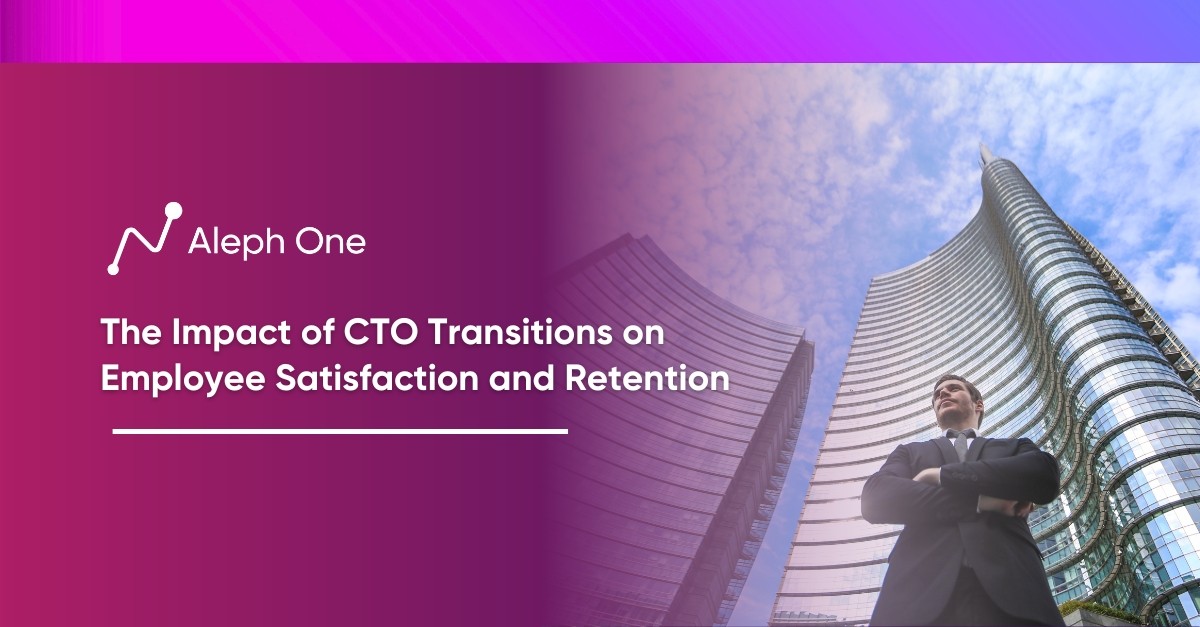Let’s work together to build something amazing. Share your project details and our team will reply to figure out the next steps to your success.

The modern tech landscape is dynamic and ever-evolving, where leaders guide their organizations through waves of innovation and transformation. One crucial figure in this dynamic is the Chief Technology Officer (CTO), who holds the reins of technological advancement and strategy. Yet, as much as these leaders drive growth and inspire progress, their departure can herald seismic shifts that resonate throughout a company. In this article, we talk about the effects of CTO transitions on employee satisfaction and retention. We explore the ripple effects these changes trigger, the innovation drain they can set in motion, and the strategies companies can employ to retain top tech talent during these times of uncertainty.

The Ripple Effects: How CTO Exits Impact Company Culture
The departure of a Chief Technology Officer often signals a major strategic shift that can significantly impact company culture and unsettle employees. CTOs play an outsized role in shaping technology vision, research priorities, and product roadmaps. Their exits mean the loss of a key leader with deep, tacit knowledge about what has worked and not worked in the past. This disruption frequently leads to uncertainty, confusion, and diminished morale among technical staff.
Lessons from Uber and Theranos
High-profile examples of CTO transitions illustrate these ripple effects. When Uber CTO Thuan Pham resigned in 2019 after nearly a decade, it highlighted the company’s cultural turmoil and raised questions about the future direction of its technology platform. The fallout from Elizabeth Holmes’ departure as Theranos CTO led to the dissolution of the entire company amid revelations of flawed technology and practices.
Broad Impact of CTO Exits
Less prominent CTO exits also reverberate through organizations. An executive search firm Spencer Stuart survey found that over two-thirds of companies experience a drop in productivity, innovation, or employee engagement during technology leadership transitions. Technical staff suddenly find their priorities and resources in flux. Pet projects may be canceled, and critical relationships need to be rebuilt. This unsettling period often spurs higher voluntary turnover, further draining institutional knowledge.
Navigating Disruption
The level of disruption depends on the nature of the CTO’s departure. Planned successions as part of a long-term transition usually proceed more smoothly than sudden exits resulting from poor performance, ethical lapses, or other involuntary reasons. However, even planned transitions require careful change management to minimize fallout. Failing to address cultural issues or communicate effectively about the implications of a CTO’s departure can significantly damage employee satisfaction, trust in leadership, and commitment to the organization’s vision.
The Innovation Drain: Why CTO Transitions Lead to Knowledge Loss
CTOs shape a company’s technology vision and research and development agenda. They make high-level decisions about platforms, partnerships, and product roadmaps that drive innovation. When a CTO departs, much of this tacit knowledge walks out the door with them.
Executive Turnover Leads to Significant Drops in Productivity
Studies show that executive turnover leads to significant drops in productivity and innovation. For example, research from Harvard Business School found that companies experience a 50 percent drop in patenting in the two years following the departure of a Chief Technology Officer. This “innovation drain” is hard to remedy since much of a CTO’s knowledge is highly specialized and contextual. Their deep understanding of technology architectures, research pipelines, and product strategies is not easily codified or replaced.
Unraveling Projects and Partnerships
Losing a CTO also disrupts existing R&D projects and relationships with external partners. New CTOs often reassess current initiatives and partnerships, changing or canceling some programs altogether. While this reevaluation process is normal and healthy, it can slow progress for months or years as teams reorient themselves under new leadership. For employees, the shifting priorities and uncertainty around the future of critical projects or partnerships may spur some to leave in search of more stable opportunities.
A Bigger Impact on Smaller Companies
The impact of a CTO transition on innovation is particularly acute for smaller companies in highly technical fields like software, biotech, and advanced manufacturing. CTOs play an oversized role in developing and executing an R&D vision in these sectors. When they leave, much of the technical expertise and strategic direction goes with them. For startups, losing a founding CTO can be devastating, significantly setting back technology and product roadmaps.
Innovation Vulnerability
CTO departures pose significant risks to innovation by draining companies of specialized knowledge and disrupting R&D programs. The impact tends to be severe for smaller, highly technical companies where CTOs are more deeply involved in technology strategy and execution. Mitigating these innovation risks is critical for companies navigating a CTO transition.
Stop the Brain Drain: How to Retain Top Tech Talent During Transition
CTO transitions often unsettle technical employees and increase the risk of talent departures. To prevent a “brain drain,” companies must take proactive steps to retain key staff during leadership changes. One of the most important strategies is open, frequent communication about the transition. Employees want to understand the company’s technology vision and how new leadership may impact their roles. Providing opportunities for staff to meet with new executives and ask questions helps address concerns and build buy-in.
Reassuring Employees Amid Change
Key projects, resources, and benefits must remain funded and staffed during the transition. Employees who feel their work or compensation may be at risk under a new CTO are likelier to start looking for other jobs. Publicly reaffirming the importance of key teams and priorities signals to employees that their contributions are still valued. If any changes are planned, communicating them transparently and gradually is essential.
Using Retention Bonuses and Perks Thoughtfully
Some companies offer retention bonuses or perks to prevent talent loss during transitions. While financial incentives can be effective, they must be used carefully to avoid signaling a lack of confidence in the new CTO or company’s direction. Non-monetary retention efforts like flexible work options, career development programs, and team-building activities are also helpful in boosting morale and engagement during leadership changes.
Successful Case Studies
A few technology companies have navigated CTO transitions with minimal impact on retention. At VMware, a succession plan helped ensure a smooth power transfer from long-time CTO Stephen Herrod to Ray O’Farrell. A multi-year leadership development program allowed O’Farrell to build strong working relationships with key staff before fully taking the reins. Similarly, when Godfrey Sullivan departed, Splunk fast-tracked the promotion of internal candidate Tim Tully to CTO. Tully’s experience, technical credibility, and strong internal relationships made him a natural successor and helped maintain employee confidence in the company’s direction.
Securing Stability Through Long-Term Succession Strategies
With the right focus on communication, continuity, and proactive retention strategies, companies can successfully navigate CTO changes without losing valuable talent or disrupting operations. But developing a long-term succession plan is the best way to set any technology organization up for stability and success, even when leadership transitions happen.
The Cost of Turnover: Why CTO Exits Significantly Impact the Bottom Line
A CTO’s departure can significantly impact a company’s bottom line due to increased employee turnover and associated costs. Research shows that the average cost of turnover for a highly skilled technical employee like a software engineer or data scientist is between 100-150% of their salary.
How CTO Transitions Drive Voluntary Turnover
CTO transitions often unsettle technical staff and signal strategic changes that prompt some employees to look for new opportunities. One study found that executive departures increase the odds of voluntary turnover in the executive’s division by over 50% in the following year. The effects are most pronounced for top talent and critical technical leads. Losing these pivotal employees can be hugely expensive.
Estimating Turnover Costs
For example, if a company with 5,000 technical employees, including 500 software engineers and 200 data scientists, experiences a 15% increase in turnover the year after a CTO’s exit, that could result in at least 165 additional departures. At a conservative cost of $150,000 per departure, total turnover costs would amount to nearly $25 million. For companies where technology and engineering are a significant competitive advantage, the long-term costs of losing key technical staff may be even higher due to slowed innovation and productivity.
Proactive Approaches to Mitigate Turnover Fallout
The lesson is clear: CTO transitions must be carefully managed to limit fallout and prevent unnecessary churn. Companies should focus on retaining pivotal talent by maintaining project funding, ensuring business continuity, and allowing key technical leads to shape new strategies. They must also work quickly to get new CTOs up to speed, address employee concerns, and communicate a compelling vision to motivate and engage technical staff. With strong succession planning and a proactive approach to change management, companies can navigate CTO departures without derailing employee satisfaction or significantly impacting their bottom line. But without these measures, the costs of turnover following a CTO’s exit may quickly add up.
A Bumpy Road Ahead: How New CTOs Can Quickly Gain Employee Buy-In
New CTOs have a short window to make a strong first impression and win over technical staff who may be wary of leadership changes. According to research from Harvard Business Review, new executives have between 6 to 18 months to gain employee trust and set the right vision before productivity and retention start to suffer. For CTOs, building credibility with highly-skilled technical teams is especially critical.
1. Communicate a Compelling Vision
The first step for new CTOs is to communicate a compelling vision for technology innovation that motivates and inspires staff. They must paint a clear picture of how the engineering organization will evolve and support key business goals. This vision should highlight opportunities for career growth and learning to keep top talent engaged. New CTOs should also address any concerns about the transition openly and honestly in all-hands meetings. Acknowledging uncertainties and fielding tough questions upfront builds trust and transparency.
2. Meet with Key Teams and Leaders
Meeting with key teams and leaders is also important for new CTOs to gain buy-in. They must make time to listen, learn and understand what is working well and not so well. New CTOs should ask open-ended questions to determine top priorities and challenges, as well as identify “pockets of innovation” to tap into. While these meetings are a chance to share their vision, new CTOs must also be receptive to feedback and make employees feel heard. Taking notes and following up with action items or next steps reinforces their commitment.
3. Avoid Making Major Disruptions in the Beginning
In the short-term, new CTOs should avoid making major disruptions or changes that could alienate staff. They must learn the lay of the land before overhauling processes or technology platforms that people have built their work around. While fresh perspectives are valuable, moving too fast risks appearing ignorant or disrespectful of the status quo. New executives who take time to evaluate existing operations and only make changes incrementally gain more employee trust and cooperation.
Navigating Leadership Transitions for New CTOs
With the right vision, transparency, listening skills, and patience, new CTOs can navigate leadership transitions smoothly and bring technical staff along with them. But they must act quickly before uncertainty and attrition start to take hold. Gaining employee buy-in out of the gate is essential for long-term success in the role.
The Takeaway: Why Companies Must Prioritize CTO Succession Planning
The departure of a CTO can have ripple effects that impact company culture, innovation, and the bottom line. However, many companies fail to adequately plan for leadership succession in their technology ranks. This is shortsighted. By investing in CTO succession planning and development, companies can ensure a smooth transfer of power that minimizes risks to employee satisfaction, retention, and productivity.
Identifying and Developing Internal Candidates
Succession planning means identifying potential internal candidates for the CTO role and cultivating their leadership abilities. This could include rotating high-potential leaders through roles with increasing responsibility, mentoring programs, or partnerships with executive coaches. Educational opportunities like attending industry conferences or executive education courses at leading business schools also help prepare next-generation CTOs.
Crafting Emergency Contingency Plans
Companies should maintain emergency contingency plans in case a CTO leaves abruptly. This means documenting key responsibilities, relationships, and in-progress projects to help a new CTO get up to speed quickly. It also means designating potential interim internal candidates who could step in for a short-term transitional period. With contingency plans in place, companies avoid scrambling to fill a leadership vacuum.
Building Strong Succession Pipelines
Leading technology companies like Google, Facebook, and Microsoft all have robust succession pipelines and talent development programs to ensure internal candidates are ready to take on the CTO mantle. They recognize that even in a fast-changing industry, certain leadership qualities like vision, communication skills, and technical depth are enduring. With time and support, promising leaders can develop these qualities and gain the experience necessary to become a successful CTO.
Investing in Continuity
In today’s competitive technology sector, companies cannot afford to be caught off guard by a CTO’s departure. Succession planning and leadership development pay significant dividends, allowing companies to maintain continuity even when faced with changes in key roles. By prioritizing CTO succession, companies are far better positioned to navigate transitions smoothly and set their next technology leader up for success. Overall, proactive planning helps turn CTO exits from potential crises into strategic opportunities.
FAQ
How can companies smoothly transition in the event of a CTO’s departure to minimize disruption to employees and productivity?
It is undeniable that the exit of a CTO brings significant disruptions to companies. However, they can mitigate these effects by meticulous planning and communication. Regularly updating employees of the inevitable changes, explaining the company’s future direction, and fostering open dialogue can maintain staff morale and productivity during the transition. Other than that, establishing a succession plan ahead of time will ensure continuity in the organization. Whenever possible, grooming potential internal candidates for the role will make the transition smoother and less drastic.
What specific strategies can companies adapt to retain top tech talent during a transition period, especially those who are directly affected by the CTO's exit?
Retaining top tech talent in the midst of a CTO’s exit revolves around creating an environment of security and stability. First, companies should ensure that key projects and resources remain adequately funded, implying that the employees’ work remains valuable despite the leadership change. Communication transparency about any new policies results in less anxiety and uncertainty among the staff. Additionally, offering perks, bonuses, and opportunities for growth can further incentivize staff to remain within the company. Creating a culture that values employees and makes them feel integral to the organization increases the chances of retaining top talent during transitions.
How can new CTOs quickly gain the trust and support of the existing technical staff while ensuring continued innovation and growth for the company?
A new CTO can quickly gain employee trust by demonstrating meaningful, open communication and a clear vision for the company. They should establish forums to interact with staff, listen to their concerns and reaffirm their roles within the company. They must also respect existing operational processes and only introduce changes after comprehensive assessments and consultations. A new CTO should aim to bring stability, inspiration, and a compelling vision to the company, which will instill confidence in their leadership and ensure continued innovation and productivity.
Get the latest news and updates from Aleph One in your inbox.



